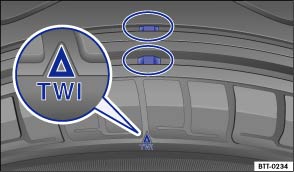Volkswagen Polo Owners Manual: Tread depth and wear indicators

Fig. 147 Tyre tread: wear indicators
 First read and observe the introductory information
and safety warnings
First read and observe the introductory information
and safety warningsTread depth
Difficult driving situations demand the deepest possible tread depth for the tyres and the same tread depth for the tyres on the front and rear axles. This applies in particular for driving in winter weather and cold temperatures and in wet conditions .
In most countries, the minimum tread depth required by law is 1.6 mm (measured in the tread grooves next to the tread wear indicators). Observe any country-specific legal requirements.
Winter tyres lose a large degree of their effectiveness when the tread is worn down to a depth of 4 mm.
The tread depth of new tyres can vary according to type and manufacturer due to construction and tread design.
Tread wear indicator in tyres
The original tyres on your vehicle have 1.6 mm high tread wear indicators running across the tread . These wear indicators are positioned at set intervals around the tyre. Markings on the tyre sidewall (for instance the letters TWI or other symbols) indicate the positions of the tread wear indicators.
The tread wear indicators show if a tyre is worn down. The tyre must be replaced at the latest when the tread depth is just down to the tread wear indicator.

 WARNING
WARNING
- Tyres must be replaced at the latest when the tread is worn down to the tread wear indicators.
- Worn tyres have considerably less tread, particularly on wet roads, which can cause the vehicle to glide along the road surface (aquaplaning).
- Worn tyres reduce the possibility of controlling the vehicle well in normal and difficult driving situations and increase braking distance and the risk of sliding.
 Tyre pressure
Tyre pressure
Fig. 146 On the inside of the tank flap:
tyre inflation pressure label
First read and observe the introductory information
and safety warningsThe correct tyre pressure for factory-fitted tyres i ...
 Tyre damage
Tyre damage
First read and observe the introductory information
and safety warningsDamage to tyres and rims is often not readily visible.
Any unusual vibrations or signs that the car is pulling
to one side ...
Other materials:
Changing the bulbs in the tail light cluster
Fig. 184 On the side of the
luggage compartment: removing the tail light cluster
Fig. 185 Tail light cluster:
removing the bulb holder
First read and observe the introductory
information and safety warnings
The steps should only be carried out in the specified order.
Removing the tail li ...
Wheel, Mounting, Volkswagen Assembly Instructions
Vehicles With Tire Pressure Monitoring Sensor.
If wheels are changed (for example, change from summer to
winter tires), wheel electronics send data as soon as speed of
new wheels exceeds 25 km/h (15.53 mph) The control module
automatical ...
Introduction
This chapter contains information on the following subjects:
→ Warning lamp
→ Opening the tailgate
→ Closing the tailgate
Additional information and warnings:
Exterior views
Central locking system
Transporting items
Manual opening and closing
...
